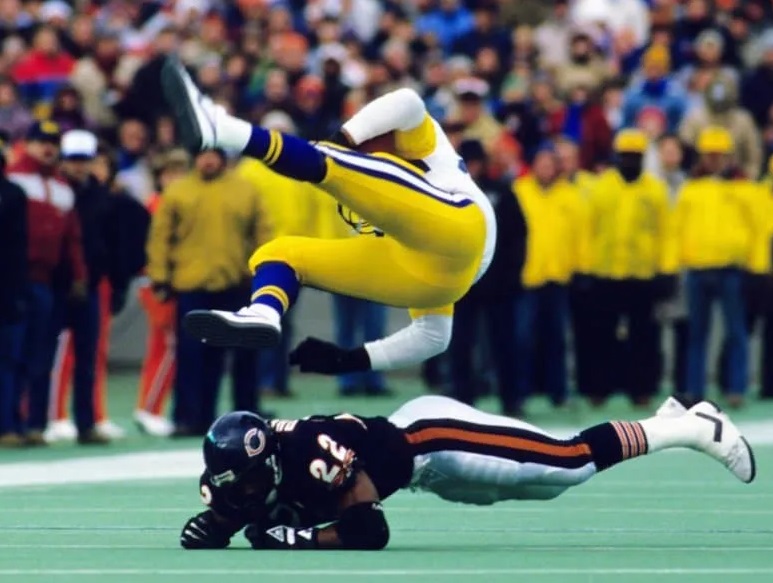Neuropathologist Bennet Omalu performed the autopsy of the extraordinary Mike Webster in 2002 and detected an advanced neurodegenerative condition in a 50-year-old. He initiated an investigation of the impact of the bruises received in the practice of American football in the brains of deceased former players, unfortunately, there is no way to detect it in life, but he encountered all kinds of obstacles and confrontations from those who did not want the results to come to light and tried to discredit him. But in 2011 his study received the shocking blow, which he, unfortunately, needed, with the suicide of Dave Duerson
Dave Duerson: The NFL player who called the league out by shooting himself in the chest

The Nigerian doctor – played by Will Smith in the 2015 film Concussion – had to face the interests of one of the most powerful sports leagues in the world. I wanted to demonstrate how the repetition of the blows received by American football players caused neurodegenerative damage that directly impacted their quality of life, forever (irreversible and without cure). He began the investigation of his life with the brain of Mike Webster – a former Pittsburgh Steelers considered one of the greatest players of all time – who died in 2002, at 50 years of age, mired in depression, chronic pain, addiction to controlled substances, loneliness, debts and voices in his head that tormented him day and night; There were electric shocks to try to be conscious as little time as possible.
Omalu was responsible for the autopsy and wondered why a high-performance athlete, who used to be a millionaire, had died in this ‘sudden’ way and lived inside a van. After analyzing Webster’s brain in a Nigerian neuropathologist, he discovered that the multiple blows received in his sports life had caused severe brain damage that had led to the terrible living conditions in which he faced his last years and caused his death.
CTE (for its acronym in English), chronic traumatic encephalopathy, is the name of the pathology that terrified the NFL for years and could not hide. Omalu concluded that Webster’s brain received impacts equivalent to 25,000 minor traffic accidents in his lifetime; Since he started playing football until he retired from professionalism.
Bennet Omalu received all kinds of criticism and attempts at discrediting, including threats. The conclusions of the study proposed by the doctor could only be ratified with observations of the brains of deceased former players, it was not possible to detect it in life; although the symptoms appeared and were difficult to ignore, such as domestic violence or sudden mood swings and chronic pain, hallucinations, etc.; They always covered themselves by arguing with other pathologies. Omalu filed for a job in 2005 and 2006 but the NFL ignored it; Only in 2009 the league considered accepting that there could be a point to attend to in what the doctor proposed, and it was the players, through the association that nucleates them, who asked to hear him.
A shot at the heart of the NFL
On February 17, 2011, Dave Duerson, a former player for the Chicago Bears, New York Giants and Phoenix Cardinals, committed suicide by shooting himself in the chest and left a letter in which he asked his family: “I want the league to analyze my brain to know why I have these headaches, I can’t concentrate, I forget things and words and I’m not who I used to be.”
Studies conducted by the Boston University School of Medicine yielded a similar result to Mike Webster: “Dave Duerson had a classic CTE pathology and no evidence of any other disease was found. He had severe damage to brain areas that control judgment, inhibition, impulse control, mood and memory,” said Dr. Ann McKee, a neuropathologist at Boston University School of Medicine Medical Center, coordinator of the Traumatic Encephalopathy Study.
“It’s important for people to understand that it’s not helpful to our mission and research for players to take their own lives because they fear having the disease. The future will offer a successful treatment for her,” said Dr. Robert Stern, co-director of the Boston University center.
NFL players became aware of the damage they were exposed to and began demanding concussion protocols and better protective conditions, especially in updating helmet-making.
On May 2, 2012, Junior Seau, a former player for the New England Patriots, San Diego Chargers and Miami Dolphins, also committed suicide by shooting himself in the chest. His body was found in a room at his home in Oceanside, California, next to a piece of paper (not a letter) on which he had the name of his favorite song: “Who I Ain’t.”